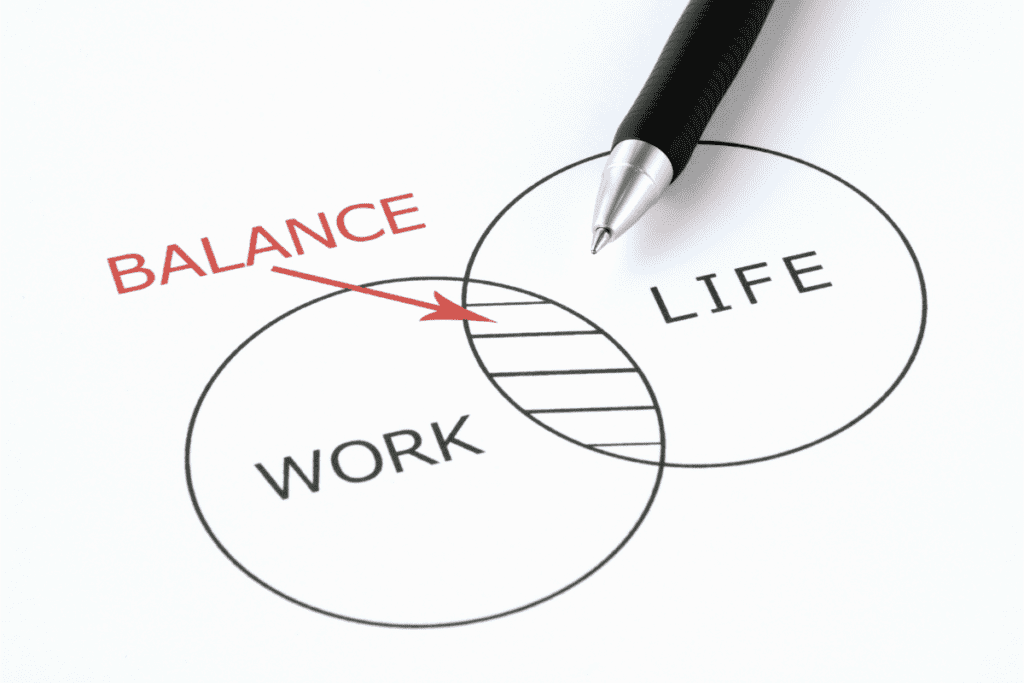Reality As A Remote Worker: Work-Life Balance Or Work-Life Integration

Ever feel like your personal life is getting eclipsed by work, even when working from home? Studies show that many remote workers struggle to strike a balance between their professional and personal responsibilities. This blog post will provide you with effective strategies for navigating the blurry line between work and life while working remotely – focusing on two concepts: work-life balance and work-life integration.
Read on, it’s time to reclaim control of your workday!
Key Takeaways
- Many remote workers struggle to find a balance between their personal and professional responsibilities, but work-life integration offers a more flexible approach.
- Work-life balance focuses on separating work hours from personal time, while work-life integration blends the two seamlessly throughout the day.
- Strategies for achieving work-life integration include choosing productive hours, creating a routine, setting boundaries and unplugging from work, developing self-awareness, and understanding and maximizing productivity.
- Employers can support work-life integration by offering flexible work arrangements, providing communication and collaboration tools, offering resources and support, and fostering a culture that prioritizes work-life integration.
What is the Difference Between Work-Life Balance and Work-Life Integration?
 Work-life integration refers to blending personal and professional responsibilities seamlessly, while work-life balance focuses on creating a clear divide between work and personal life.
Work-life integration refers to blending personal and professional responsibilities seamlessly, while work-life balance focuses on creating a clear divide between work and personal life.
Definition of work-life integration
Work-life integration is a way to mix work and personal life. It is not about keeping the two areas separate. Instead, it lets you blend work duties with personal tasks. It gives more flow between work and home life.
An example of this is taking your child to a doctor’s appointment in the middle of a workday and then catching up on work tasks later in the evening. This approach recognizes that life’s responsibilities don’t always fit neatly into traditional a traditional work schedule. Instead of rigidly adhering to a 9-to-5 schedule, work-life integration allows for flexibility, ensuring that both professional and personal commitments are met without compromising on either. It’s about weaving work and life together in a way that suits your unique circumstances and priorities, creating a harmonious blend that fosters productivity and personal fulfillment.
This can be important for those who are working from home or far away from an office. Work-life integration knows that your job and private life often come together.
Definition of work-life balance
Work-life balance is about separating work hours from personal time. It works like a time management system that puts clear borders between job tasks and home life. This setup helps workers handle their job duties and personal stuff well.
When you have work-life balance, you feel good because you can do your job and enjoy your free time too.
A balanced work-life routine leads to more engagement at work, better productivity, and keeps employees happy in the long run. Employees will want to stay longer with companies where they feel valued and also have enough personal space to unwind after a busy day at work.
Work-life balance doesn’t only promote employee satisfaction but it’s healthy for businesses as well.
Differences between work-life integration and work-life balance
Work-life balance and work-life integration are not the same.
What’s the difference? Work-life balance means that you draw strict lines between your job and personal life. You have clear office hours. After work, focus is on home or personal activities only. These boundaries between work and home tend to be inflexible.
With work-life integration, these lines are blurry. Job tasks mix with home duties throughout the day. to provide more of a balance between work responsibilities and life responsibilities. This model gives more room to adjust things as needed in a day’s time frame for both work tasks and personal activities.
The two models offer different ways to manage work and personal responsibilities based on one’s needs, habits, and lifestyle.
What are Some Key Strategies for Achieving Work-Life Integration as a Remote Worker?

To achieve work-life integration as a remote worker, it is important to choose productive hours, create a routine, set boundaries and unplug from work, develop self-awareness, and understand and maximize productivity.
Choosing productive hours
Finding the right time to work can greatly impact your productivity as a remote worker. Each person has their own productive hours where they are more charged up and focused on finishing tasks efficiently.
Some people may find that early mornings are when they are most alert and motivated, while others may feel more energized and productive in the evenings. It is important to pay attention to your body’s natural rhythm and identify the times when you feel most engaged and capable of getting work done effectively.
By choosing these productive hours for your work activities, you can maximize your output and make the most of your time as a remote worker.
Creating a routine
Creating a routine is an important strategy for achieving work-life integration as a remote worker. When you have a set schedule, it helps you to stay organized and manage your time effectively.
By establishing regular working hours, you can create boundaries between your work and personal life. Additionally, having a routine allows you to plan your day in advance and prioritize tasks based on their importance.
Remember that everyone’s routine will be different, so find what works best for you in terms of when you are most productive and focused. By sticking to a routine, remote workers can maintain a healthy work-life balance and ensure that they have time for both their professional responsibilities and personal activities.
Implementing regular breaks into your routine is also crucial for maintaining productivity and avoiding burnout. Research shows that taking short breaks throughout the day can actually increase efficiency and focus.
So make sure to include dedicated break times in your schedule where you can step away from your workspace, stretch or do something enjoyable during these moments away from work tasks.
Setting boundaries and unplugging
Setting boundaries and unplugging are crucial for maintaining a healthy work-life integration as a remote worker. Blurred lines between work and personal life can lead to increased stress and burnout.
To establish boundaries, it is important to create physical barriers in your workspace, such as designating a specific area for work. This helps separate your personal activities from work tasks.
Additionally, setting clear expectations with yourself, your household, and your team at work can help maintain these boundaries. It’s also important to unplug from work regularly to recharge and avoid constant stress.
Developing self-awareness
Developing self-awareness is crucial for remote workers, especially when it comes to achieving work-life integration. By being self-aware, you can better understand your needs and priorities.
This allows you to set boundaries between work and personal life, ensuring that you have time for both. Self-awareness also helps in managing and prioritizing tasks effectively, leading to increased productivity.
Research shows that remote workers who are self-aware tend to be happier and more successful in accomplishing their goals. Remember, developing self-awareness is an ongoing process that requires continuous reflection and adjustment.
Understanding and maximizing productivity
To achieve work-life integration as a remote worker, it’s important to understand and maximize productivity. This means finding effective ways to manage your time and tasks so you can accomplish more in less time.
One strategy is to prioritize your most important tasks and tackle them during your peak productive hours. Creating a routine can also help you stay focused and motivated throughout the day.
Setting boundaries and taking regular breaks will prevent burnout and allow you to recharge. Developing self-awareness about your work habits can help you identify areas for improvement and make adjustments accordingly.
How Employers Can Support Work-Life Integration for Remote Workers?
Employers can support work-life integration for remote workers by offering flexible work arrangements, providing communication and collaboration tools, offering resources and support, and fostering a culture that prioritizes work-life integration.
Flexible work arrangements
Flexible work arrangements have become increasingly popular, especially in the remote and hybrid work environments. These arrangements allow employees to have more control over their schedules and where they work from, whether it’s from home or a coworking space.
Research shows that flexible work arrangements lead to greater work-life integration and improved work-life balance for teleworking professionals. Small business owners should consider implementing flexible work options as they offer flexibility for both the employer and employee, allowing for better adaptation to changing circumstances.
This can result in higher productivity, increased job satisfaction, and better time management for employees. By providing these flexible arrangements, small businesses can create a positive working environment that promotes a healthy balance between personal and professional responsibilities.
Communication and collaboration tools
Virtual collaboration tools are essential for remote workers to effectively communicate and work together. These tools allow employees to collaborate as if they’re in the same conference room, bridging the gap between remote teams.
For example, Microsoft Teams is a popular tool that offers features like audio calling, meeting scheduling, and integrated chat and messaging. By utilizing these tools, small business owners can ensure their remote employees can work together efficiently and maintain a sense of teamwork and collaboration.
Effective communication is crucial for remote work success, and virtual collaboration tools make it possible.
Providing support and resources
Small business owners have an important role in supporting work-life integration for their remote employees. This can be done by offering resources and support to help employees manage their personal and professional responsibilities effectively.
Providing access to mental health support, wellness programs, and flexible work arrangements are key ways that employers can assist remote workers in achieving a better work-life balance.
These initiatives promote employee well-being, reduce stress, and ultimately lead to increased productivity. Additionally, clear communication about schedule expectations and offering benefits like childcare assistance or tuition reimbursement further demonstrate a commitment to supporting work-life integration for remote workers.
Fostering a culture of work-life integration
Fostering a culture of work-life integration is crucial for small business owners to support their remote workers. It involves creating an environment where personal and professional needs are valued and respected.
By encouraging open communication, setting clear boundaries, and promoting self-care, businesses can help employees achieve a healthy work-life balance. Providing flexible work arrangements that allow for autonomy and choice also contributes to a positive culture of work-life integration.
Small business owners should prioritize the well-being of their remote workers by offering resources, support for physical and mental health, and opportunities for growth and development.
FAQs
1. What is the difference between work-life balance and work-life integration?
Work-life balance is about creating firm boundaries between home and work. Work-life integration mixes work and personal hours.
2. How does working from home impact work life?
Working from home blurs the lines between “work” time and “personal” time, leading to a shift towards work-life integration.
3. Has the pandemic affected how we view our Work Life Balance or Integration?
Yes, due to being fully remote after the pandemic; many workers now have to complete their tasks without leaving their homes which has brought an increased need for understanding effective ways for attempting “work-life” or “work-life integration”.
4. Why isn’t Work-Life Balance always possible when you’re working remotely?
Sometimes our “home office” overlaps with our living space causing difficulty maintaining firm boundaries where “work isn’t invading your life outside of your planned ‘work day'”.
5. How do I achieve a good level of ‘Work-Life Integration’ while working remotely?
You may integrate workflow within your daily routine by adjusting your schedule according to flexible “times that help manage both your return-to-work responsibilities along with accomplishing other household duties efficiently”.
Conclusion
In today’s remote work reality, achieving work-life balance can be challenging. However, the concept of work-life integration offers a more flexible approach to blending personal and professional responsibilities.
By implementing strategies like setting boundaries, creating routines, and maximizing productivity during productive hours, remote workers can find harmony between their work and personal lives.
Employers also play a crucial role in supporting work-life integration by offering flexible arrangements and providing the necessary tools and resources. Ultimately, finding the right balance or integration is essential for maintaining well-being and thriving as a remote worker.
If you liked this article, remember to subscribe to MiamiCloud.com. Connect. Learn. Innovate.






